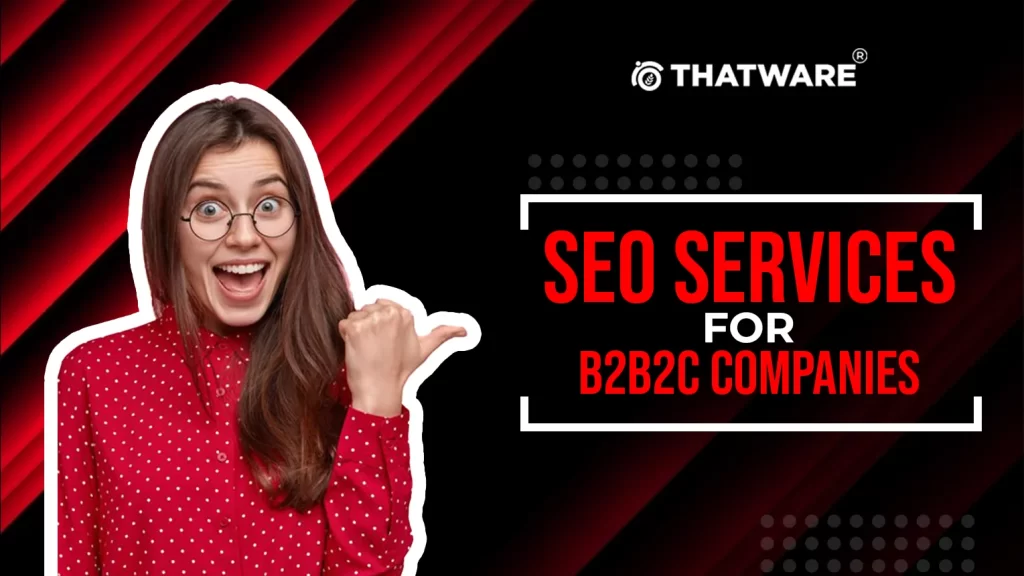GET A FREE CUSTOMIZED SEO AUDIT & DIGITAL MARKETING STRATEGY FOR YOUR B2B2C BUSINESS
The business landscape has undergone a profound transformation with the emergence of the B2B2C model, a dynamic approach that serves as a bridge between businesses and end consumers. In this section, we delve into the intricacies of integrated SEO for B2B and B2C, defining its structure, emphasizing the pivotal role of SEO, and providing an insightful overview of the continuously evolving digital landscape.

At its core, the B2B2C model, abbreviated for Business to Business to Consumer, represents a unique business strategy where companies act as intermediaries, facilitating transactions between other businesses and end consumers. This introductory segment aims to define the B2B2C model, elucidating its structure and the relationships it fosters in the business ecosystem.
Search Engine Optimization (SEO) stands as a linchpin for B2B2C companies navigating the digital sphere. This subsection explores the indispensable role that SEO plays in enhancing the online presence of businesses operating within the B2B2C framework. B2B2C SEO strategies shed light on the transformative impact of SEO on customer acquisition, retention, and overall brand visibility.
The digital landscape is a constantly shifting terrain, and this part of the introduction provides an insightful overview of the ongoing evolution in the digital realm. It touches upon the emerging trends, technologies, and consumer behaviours that impact B2B2C interactions, setting the stage for understanding the strategic importance of SEO in this dynamic environment.
I. Understanding the B2B2C Model
To comprehend the nuances of the B2B2C model, this section delves deeper into its definition, characteristics, key players, and the distinct challenges and opportunities it presents.
Definition and Characteristics
The B2B2C model combines elements of both B2B and B2C strategies. This subsection explores the defining characteristics that set B2B2C apart, such as the dual nature of transactions, diversified customer relationships, and a unique market positioning that requires a delicate balance.
Key Players in B2B2C Ecosystems
The B2B2C ecosystem is composed of key players, each contributing to the intricate web of transactions. From manufacturers and distributors to online platforms and service providers, understanding the roles of these entities is crucial for comprehending the dynamics within this model.
Unique Challenges and Opportunities
The B2B2C model presents a distinctive set of challenges and opportunities. This part of the section explores the hurdles businesses face in maintaining equilibrium between serving other businesses and catering to end consumers. Simultaneously, it highlights the potential advantages and growth prospects inherent in this multifaceted model.
II. The Significance of SEO in B2B2C
Now, the focus shifts to the heart of the discussion – the critical role of SEO for B2B and B2C synergy.
Role of SEO in Enhancing Online Visibility
This segment unravels the intricate ways in which SEO acts as a catalyst for improving the online visibility of B2B2C businesses. From website optimization to strategic keyword targeting, it delves into the core practices that contribute to heightened visibility in search engine results.
SEO’s Impact on Customer Acquisition and Retention
The narrative here centres on the transformative impact of SEO on customer acquisition and retention strategies. It explores how a well-crafted SEO approach can attract a diverse customer base, foster brand loyalty, and ultimately drive sustainable growth for B2B2C entities.
Aligning SEO Strategies with B2B2C Goals
Lastly, this subsection emphasizes the importance of aligning SEO strategies with the specific goals of B2B2C businesses. It discusses the need for a tailored approach that considers the dual nature of the model, catering to both business clients and end consumers.
In the subsequent sections of this comprehensive exploration, we will delve further into the tactical aspects of SEO in B2B2C, exploring content optimization, local SEO, and emerging trends shaping the future of this dynamic business model.
III. Tailoring SEO Strategies for B2B2C Companies
In the intricate world of the B2B2C model, where businesses serve as intermediaries between other businesses and end consumers, the efficacy of B2B2C SEO strategies becomes paramount. Tailoring these strategies to the unique demands of the B2B2C environment is essential for navigating the complexities of this dynamic business model.
Keyword Research and Targeting
Keyword research stands as the bedrock of any successful SEO strategy, and in the context of B2B2C, it takes on a nuanced significance. Understanding the distinct search queries of both businesses and consumers is crucial. B2B entities may use industry-specific jargon, while B2C customers might employ more consumer-friendly terms. Effective keyword targeting involves a delicate balance, ensuring that the content resonates with both audiences. Comprehensive keyword research tools and a profound understanding of the industry landscape are indispensable in crafting a strategy that captures the diverse linguistic nuances of the B2B2C space.
Content Optimization for Diverse Audiences
In the realm of B2B2C, content serves as the bridge between the technical specifications craved by businesses and the user-friendly information sought by consumers. Crafting content that speaks to both audiences requires a strategic approach. Product descriptions, for instance, may need to encompass technical details for B2B clients while maintaining clarity and simplicity for the end consumer. Localized SEO optimization extends beyond text to include multimedia elements, ensuring that the information is digestible for both business professionals and individual consumers. This dual-focus content strategy enhances SEO and contributes to a positive user experience for all stakeholders.
Mobile Optimization and User Experience
In an era where mobile devices dominate online interactions, mobile optimization is non-negotiable for SEO success. For B2B2C companies, this entails creating a seamless mobile experience for both business users and individual consumers. The mobile interface should facilitate easy navigation, quick access to pertinent information, and a responsive design that adapts to various screen sizes. This optimization not only caters to the preferences of diverse user groups but also aligns with search engine algorithms that prioritize mobile-friendly websites. As user experience is a critical component of SEO ranking factors, ensuring that both B2B and B2C users can effortlessly engage with the content on mobile devices becomes a strategic imperative.

Tailoring SEO strategies for B2B2C companies is a multifaceted endeavour that requires a nuanced understanding of both business and consumer dynamics. From precision in keyword research to the seamless optimization of content for diverse audiences and the meticulous crafting of mobile experiences, each element contributes to an overarching strategy aimed at elevating online visibility and engagement in the unique landscape of the B2B2C model. In the subsequent sections, we will explore further dimensions of interconnected SEO solutions, including local optimization and the incorporation of emerging trends in this dynamic business environment.
IV. Leveraging Content Marketing in B2B2C SEO
In the intricate world of the B2B2C model, where businesses serve as intermediaries between other businesses and end consumers, content marketing becomes a linchpin for a successful SEO strategy. This section explores the nuances of leveraging content marketing to resonate with both businesses and consumers, crafting a strategy that embraces diversity and interactivity.
Creating Compelling Content for Both Businesses and Consumers
The essence of content marketing in the B2B2C space lies in the ability to create content that speaks to the unique needs and preferences of both business clients and individual consumers. For B2B audiences, content should delve into technical specifications, industry trends, and the potential business impact of products or services. Simultaneously, the content must be accessible and engaging for B2C consumers, focusing on benefits, user experiences, and relatable narratives. Striking this delicate balance requires a deep understanding of the distinct pain points and aspirations of both segments, ensuring that the content is not only informative but also compelling for all stakeholders.
Developing a Content Strategy that Resonates with Diverse Audiences
Crafting proactive SEO solutions that resonate with the diversity inherent in the B2B2C model is a strategic imperative. This involves aligning content creation with the different stages of the buyer’s journey for both businesses and consumers. For B2B clients, content may emphasize research papers, case studies, and in-depth analyses. On the consumer side, the focus might shift towards engaging blog posts, product demonstrations, and user-generated content. Understanding the nuanced preferences and decision-making processes of each audience segment is essential in developing a comprehensive content strategy that guides users seamlessly through the conversion funnel.
Incorporating Multimedia and Interactive Content
In the dynamic landscape of B2B2C, where visual appeal and interactive experiences are paramount, incorporating multimedia elements into content marketing strategies is instrumental. Infographics, videos, webinars, and interactive product demos can enhance engagement levels for both B2B and B2C audiences. Visual content aids in conveying complex information to business clients, while simultaneously catering to the consumer’s preference for visually digestible content. Furthermore, interactive elements such as quizzes, surveys, and augmented reality experiences can elevate user engagement, providing a personalized touch that resonates with diverse audiences.
Leveraging content marketing in B2B2C SEO requires a thoughtful and adaptive approach. The creation of compelling content that addresses the unique needs of businesses and consumers, the development of a strategy that guides diverse audiences through their respective buyer’s journeys, and the incorporation of multimedia and interactive elements are key pillars in this endeavor. As we delve deeper into the intricacies of B2B2C SEO, the subsequent sections will explore additional dimensions, including the role of social media and the integration of emerging technologies in content marketing for this dynamic business model.
V. The Power of Local SEO in B2B2C
In the innovative SEO for interconnected markets, where businesses act as intermediaries linking other businesses to end consumers, harnessing the power of local SEO emerges as a strategic game-changer. This section delves into the significance of local search, the optimization techniques for local keywords and geotargeting, and the critical management of online reviews and reputation in the dynamic B2B2C landscape.
Importance of Local Search for B2B2C Companies
Local search is a pivotal component for B2B2C companies, facilitating targeted engagement with both businesses and consumers within specific geographical areas. For B2B interactions, local search enables businesses to connect with nearby partners, suppliers, or distributors, fostering collaborative relationships that thrive on proximity. On the consumer front, local search ensures that businesses are visible and accessible to individuals seeking products or services in their immediate vicinity. The importance of local search is amplified in the B2B2C model, where the dual focus on businesses and consumers necessitates a localized approach to maximize impact.
Optimizing for Local Keywords and Geotargeting
To unlock the full potential of the local user-centric B2B2C SEO landscape, optimizing content for local keywords and employing geo targeting strategies is paramount. Localized keywords ensure that businesses and products surface prominently in search results when users within specific regions conduct relevant queries. Geotargeting further refines this approach by tailoring content delivery based on the user’s location. Whether a B2B entity is searching for local suppliers or a consumer is seeking nearby retail outlets, the optimization of content for local keywords and geotargeting enhances visibility, driving targeted traffic and conversions.
Managing Online Reviews and Reputation
In the interconnected world of B2B2C, online reputation serves as a digital currency. Managing online reviews becomes a strategic imperative to foster trust and credibility among both businesses and consumers. B2B clients may rely on reviews to evaluate the reliability and professionalism of potential partners, while consumers often make purchasing decisions based on the experiences shared by others. Actively soliciting and responding to reviews, addressing concerns promptly, and showcasing positive feedback contributes to a positive online reputation. This influences local search rankings and establishes the credibility of B2B2C businesses according to their varied audience.
The power of SEO agility for B2B2C success lies in its ability to connect businesses and consumers in specific geographic areas, tailoring content and visibility to the unique needs of local markets. By recognizing the importance of local search, optimizing for local keywords and geotargeting, and actively managing online reviews and reputation, B2B2C companies can amplify their local presence and build meaningful connections in the communities they serve. As we navigate deeper into the complexities of B2B2C SEO, subsequent sections will explore additional facets, including the role of social media and emerging technologies in this dynamic business model.
VI. Technical SEO for B2B2C Excellence
In the intricate landscape of B2B2C, where businesses orchestrate connections between other businesses and end consumers, technical SEO emerges as a cornerstone for achieving online excellence. This section delves into the critical elements of technical SEO, focusing on website structure and navigation, page speed optimization, and the imperative of mobile-first indexing and responsive design.
Website Structure and Navigation
The foundation of conversion-focused SEO for B2B2C excellence lies in the meticulous design of website structure and navigation. A well-organized and user-friendly structure not only enhances the overall user experience but also plays a pivotal role in search engine rankings. For B2B interactions, a clear and intuitive website structure ensures that businesses can efficiently navigate through product catalogs, technical specifications, and relevant resources. Simultaneously, on the B2C front, consumers benefit from easy navigation, intuitive menus, and a seamless journey from product discovery to purchase. Implementing a hierarchy that accommodates the diverse needs of both audiences is instrumental in optimizing the website for search engines and enhancing user satisfaction.
Page Speed Optimization
In the fast-paced digital landscape, page speed optimization is not just a user convenience but a crucial ranking factor for search engines. B2B2C companies must prioritize minimizing page load times to cater to the expectations of both businesses and consumers. Slow-loading pages can lead to higher bounce rates, affecting user engagement and, subsequently, search engine rankings. Optimizing images, leveraging browser caching, and minimizing unnecessary scripts are just a few strategies to enhance page speed. By ensuring swift and responsive web pages, B2B2C entities create an environment that is conducive to both efficient business transactions and seamless consumer interactions.
Mobile-First Indexing and Responsive Design
As mobile devices dominate the online landscape, embracing mobile-first indexing and responsive design is non-negotiable for B2B2C excellence in technical SEO. Search engines prioritize mobile-friendly websites, considering the prevalence of mobile searches. For mobile-first SEO excellence, a mobile-friendly interface ensures that businesses can access essential information on the go, facilitating quick decisions and collaborations. On the consumer side, a responsive design guarantees a positive mobile experience, allowing for easy product exploration and streamlined purchase processes. B2B2C companies must align their technical SEO strategies with the mobile preferences of both businesses and consumers, optimizing for diverse devices and screen sizes.
Technical SEO serves as the backbone for B2B2C excellence, addressing the unique needs of both businesses and consumers in the digital realm. By focusing on website structure and navigation, prioritizing page speed optimization, and embracing mobile-first indexing with responsive design, B2B2C entities create a digital environment that is not only search engine-friendly but also caters to the diverse preferences of their varied audience. As we delve deeper into the intricacies of B2B2C SEO, subsequent sections will explore additional dimensions, including the role of social media and the integration of emerging technologies in this dynamic business model.
VII. Building Backlinks in B2B2C SEO
In the complex web of B2B2C, where businesses play a pivotal role as intermediaries connecting other businesses to end consumers, the art of building backlinks emerges as a strategic linchpin for performance-driven B2B2C SEO. This section navigates the process of building backlinks, emphasizing the identification of relevant industry partners, the crafting of a backlink strategy catering to both B2B and B2C audiences, and the critical aspect of measuring the impact of backlinks on SEO performance.
Identifying Relevant Industry Partners
The first step in building backlinks in the B2B2C arena is the identification of relevant industry partners. For B2B interactions, this involves pinpointing businesses within the same sector or complementary industries that can strengthen collaboration and credibility. On the B2C front, identifying influencers, bloggers, or consumer-oriented platforms becomes imperative. These partners should not only align with the values and objectives of the B2B2C entity but also possess a substantial online presence. Establishing connections with these industry partners lays the groundwork for a robust backlink strategy that resonates with both businesses and consumers.
Crafting a Backlink Strategy for Both B2B and B2C Audiences
In the context of multichannel SEO strategies, a successful backlink strategy in the B2B2C landscape must be a delicate blend, catering to the distinct needs and preferences of both business and consumer audiences. For B2B entities, this might involve guest posting on industry-specific forums, collaborating on research projects, or participating in business-oriented events. Simultaneously, on the B2C front, strategies may include influencer collaborations, product reviews on consumer platforms, or engaging in partnerships with popular blogs. The content associated with backlinks should be tailored to provide value to both audiences, striking a balance between technical depth and consumer-friendly language. Crafting a strategy that seamlessly integrates with the diverse aspects of the B2B2C model ensures that backlinks contribute to holistic SEO success.
Measuring the Impact of Backlinks on SEO
The efficacy of a backlink strategy lies in the ability to measure its impact on SEO performance. B2B2C companies must employ robust analytics tools to track the influence of backlinks on search engine rankings, website traffic, and conversion rates. Metrics such as domain authority, click-through rates, and referral traffic offer insights into the performance of backlinks across both business and consumer-oriented platforms. By understanding the correlation between backlinks and SEO outcomes, B2B2C entities can refine their strategies, emphasizing collaborations that deliver tangible results for both audience segments.
Building backlinks in B2B2C SEO is a strategic dance that involves identifying relevant industry partners, crafting a nuanced strategy for both B2B and B2C audiences, and rigorously measuring the impact on SEO metrics. By aligning backlink efforts with the diverse needs of businesses and consumers, B2B2C entities can create a network of connections that not only enhances search engine visibility but also fosters credibility and authority in their dynamic digital landscape. As we delve deeper into the complexities of B2B2C SEO, subsequent sections will explore additional dimensions, including the role of social media and the integration of emerging technologies in this dynamic business model.
VIII. Data Analytics and SEO Performance Measurement
In the intricate dance of B2B2C SEO, where businesses connect with other businesses to reach end consumers, the role of data analytics is paramount. This section unravels the essence of setting measurable goals, utilizing analytics tools for performance tracking, and making data-driven decisions for continuous improvement in the dynamic landscape of B2B2C SEO.
Setting Measurable Goals for B2B2C SEO
The foundation of effective data analytics in B2B2C SEO lies in setting clear and measurable goals. Whether the objectives revolve around increasing organic traffic, improving search engine rankings, or enhancing conversion rates, each goal must be quantifiable. For B2B interactions, goals may include strengthening partnerships, expanding market reach, or optimizing supply chain interactions. On the B2C front, goals might involve boosting consumer engagement, increasing online visibility, or driving direct sales. Defining these goals provides a roadmap for the subsequent data analytics journey, ensuring that every metric measured aligns with the overarching objectives of the B2B2C entity.
Utilizing Analytics Tools to Track Performance
With goals in place, the next step involves leveraging advanced analytics tools to meticulously track performance across the B2B and B2C spectrum. Google Analytics, SEMrush, and Moz are among the arsenal of tools that provide insights into website traffic, user behavior, keyword performance, and more. For B2B entities, analytics might focus on lead generation, partnership growth, and supply chain efficiency. Simultaneously, B2C considerations may include consumer engagement, conversion rates, and the effectiveness of marketing campaigns. The key is to tailor analytics approaches to the unique needs of both audience segments, ensuring a comprehensive understanding of how SEO efforts impact the holistic B2B2C ecosystem.
Making Data-Driven Decisions for Continuous Improvement
In the realm of B2B2C SEO, where agility and adaptability are paramount, making data-driven decisions becomes the linchpin for continuous improvement. Analysing the data gleaned from SEO performance metrics allows B2B2C entities to identify strengths, weaknesses, and opportunities for refinement. For B2B interactions, this might involve optimizing collaboration channels, refining supply chain logistics, or enhancing product visibility. On the strategic content marketing for B2B2C, data-driven decisions could entail refining consumer-focused content, improving user experience, or adjusting marketing strategies based on consumer behaviour. The iterative process of using data to inform decisions creates a cycle of continuous improvement, where SEO strategies evolve in real-time to meet the ever-changing demands of the interconnected B2B2C landscape.
The symbiotic relationship between data analytics and B2B2C SEO is a dynamic force that propels businesses toward their goals. By setting measurable objectives, leveraging analytics tools to track performance across B2B and B2C domains, and making data-driven decisions for continuous improvement, B2B2C entities can navigate the complexities of the digital realm with precision and adaptability. As we delve deeper into the intricacies of B2B2C SEO, subsequent sections will explore additional dimensions, including the role of social media and the integration of emerging technologies in this dynamic business model.

X. SEO Trends for Future B2B2C Success
As the landscape of digital commerce evolves, B2B2C entities must stay ahead of the curve by embracing emerging SEO trends. This section unveils the future of B2B2C success, focusing on voice search optimization, the integration of AI and machine learning in SEO, and the profound impact of emerging technologies on the SEO landscape.
Voice Search Optimization
Voice search has emerged as a game-changer in the way users interact with search engines. B2B2C entities aiming for future success must prioritize voice search optimization. With the proliferation of virtual assistants like Siri, Alexa, and Google Assistant, consumers and businesses alike are adopting voice commands to search for information, products, and services. Optimizing content for natural language queries and understanding the conversational nuances of voice searches becomes imperative. B2B2C SEO best practices should encompass the creation of content that aligns with spoken search queries, ensuring visibility in the rapidly expanding realm of voice-driven search.
AI and Machine Learning in SEO
The integration of artificial intelligence (AI) and machine learning (ML) is reshaping the SEO landscape for B2B2C success. In AI-powered B2B2C SEO, AI algorithms analyse vast datasets to understand user behaviour, preferences, and intent. This, in turn, allows for more personalized and relevant search results. B2B entities can leverage AI-driven insights to understand the intricate needs of businesses, tailor content for specific industries, and enhance user experience in B2B interactions. On the consumer front, AI and ML enable B2C entities to predict consumer behaviour, personalized product recommendations, and optimize marketing strategies. The symbiotic relationship between AI, ML, and SEO ensures that B2B2C entities can adapt to the evolving expectations of both business partners and end consumers.
Emerging Technologies and Their Impact on SEO
The future of local search optimization for B2B2C is intricately intertwined with the rapid advancements in emerging technologies. From augmented reality (AR) and virtual reality (VR) to the Internet of Things (IoT), these technologies are poised to revolutionize the way users engage with online content. B2B2C entities must anticipate and embrace these changes to maintain a competitive edge. AR and VR can enhance the product visualization experience for B2B clients, facilitating virtual product demos and collaborations. On the consumer side, IoT can create interconnected ecosystems, influencing search queries related to smart home devices and wearable technology. Staying abreast of these emerging technologies ensures that B2B2C SEO strategies are not only relevant but also visionary, preparing businesses for the digital landscape of tomorrow.
The future of B2B2C success in SEO lies in the strategic adoption of trends that align with the evolving preferences of both businesses and consumers. Voice search optimization, the integration of AI and machine learning, and the embrace of emerging technologies pave the way for B2B2C entities to thrive in the dynamic digital marketplace. As the digital landscape continues to evolve, B2B2C SEO strategies must remain agile, adaptable, and forward-thinking to ensure sustained success in the ever-changing world of online commerce.
XI. Challenges and Solutions in B2B2C SEO
Navigating the complex terrain of SEO innovations in B2B2C comes with its unique set of challenges. This section unveils the common hurdles faced by businesses operating in the interconnected world of B2B and B2C and provides insights into effective solutions to overcome these challenges.
Addressing Common Challenges
- Divergent Audience Needs:
Challenge: B2B and B2C audiences have distinct needs, making it challenging to create content that resonates with both.
Solution: Implement a segmented content strategy, tailoring materials for each audience segment. Utilize personalized landing pages and targeted messaging to address specific pain points.
- Balancing Technical Depth and Consumer-Friendly Content:
Challenge: B2B content often requires technical depth, while B2C demands simplicity. Balancing both can be daunting.
Solution: Create layered content. Offer a concise overview for consumers and provide in-depth technical details accessible through links for B2B clients. This ensures both audiences receive relevant information.
- Managing Large Product Inventories:
Challenge: B2B2C entities with extensive product catalogs face the challenge of optimizing a vast array of product pages.
Solution: Implement a robust categorization system, utilize filters, and invest in a user-friendly search function. Prioritize high-impact products and regularly update content for relevance.
- Ensuring Consistency Across Platforms:
Challenge: For adaptive SEO for changing markets, maintaining a consistent brand image across diverse B2B and B2C platforms can be demanding.
Solution: Develop comprehensive brand guidelines that encompass both business and consumer-facing aspects. Regularly audit online platforms to ensure consistent messaging, visuals, and branding elements.
Implementing Effective Solutions
- Integrated Marketing Strategies:
Solution: Adopt integrated marketing strategies that seamlessly blend B2B and B2C efforts. Consistent messaging, aligned branding, and synchronized campaigns enhance overall visibility.
Dynamic Content Optimization:
Solution: Embrace dynamic content optimization tools that allow real-time adjustments based on user behaviour. Tailor content dynamically to cater to the evolving needs of both business partners and end consumers.
- Advanced Analytics for Audience Segmentation:
Solution: Implement advanced analytics tools to gain insights into audience behaviour. Utilize data to create refined segments, allowing for targeted marketing efforts toward specific B2B and B2C demographics.
- Agile SEO Strategies:
Solution: Develop agile SEO strategies that can adapt to the changing demands of the B2B2C landscape. Regularly reassess keyword strategies, content relevance, and user experience to stay ahead of industry shifts.
The challenges in B2B2C SEO are nuanced but surmountable with strategic solutions. By addressing the divergent needs of both audiences, balancing technical and consumer-friendly content, managing large inventories effectively, and ensuring consistent branding, businesses can thrive in the interconnected world of B2B and B2C. Implementing integrated marketing strategies, dynamic content optimization, advanced analytics, and agile SEO approaches will fortify B2B2C entities against the challenges and position them for sustained success in the digital marketplace.

ThatWare’s Pioneering Contribution to B2B2C Companies’ SEO Services
In the ever-evolving realm of digital marketing, ThatWare emerges as a trailblazer, bringing innovative and impactful contributions to the tailored SEO for diverse audiences. This section unravels the distinctive features and transformative contributions of ThatWare, positioning it as a catalyst for success in the interconnected world of B2B and B2C.
1. Advanced AI-Driven SEO Strategies:
At the heart of ThatWare’s contribution lies its commitment to harnessing the power of Artificial Intelligence (AI) in SEO strategies. With a focus on predictive analytics and machine learning, ThatWare’s AI-driven SEO for B2B2C ensures that B2B2C entities stay ahead of the curve. The sophisticated algorithms analyse vast datasets, providing insights into user behaviour, preferences, and intent. This enhances the overall user experience and enables personalized and targeted SEO campaigns. Through AI, ThatWare empowers businesses to understand the nuanced needs of both business partners and end consumers, creating a harmonious synergy in the B2B2C landscape.
2. Hyper-Personalized Content Marketing:
One of the standout contributions of ThatWare to B2B2C SEO services is its emphasis on hyper-personalized content marketing. Recognizing the divergent needs of B2B and B2C audiences, ThatWare crafts content strategies that resonate with each segment. Through sophisticated content optimization tools and hyper-personalized SEO strategies, businesses can deliver tailored messaging that caters to the technical depth required by B2B clients and the simplicity demanded by B2C consumers. This hyper-personalization ensures that businesses effectively communicate their value propositions to both sets of audiences, fostering engagement and conversions.
3. Local SEO Excellence:
ThatWare places a premium on the significance of local SEO for B2B2C entities. Understanding the importance of localized search results, ThatWare tailors strategies to optimize for local keywords, implement geotargeting techniques, and manage online reviews and reputation effectively. This localized approach enhances the visibility of businesses in specific regions, catering to the unique demands of both B2B and B2C markets. By ensuring that businesses appear prominently in local searches, ThatWare contributes to fostering strong connections between businesses and their immediate communities.
4. Innovative Technical SEO Practices:
In the realm of technical excellence, ThatWare stands out for its innovative practices. From optimizing website structure and navigation to ensuring responsive design and mobile-first indexing, ThatWare’s technical SEO strategies are designed for excellence. By prioritizing page speed optimization and providing a seamless user experience across devices, ThatWare contributes to the overall health and performance of B2B2C entities’ online presence.
5. Data-Driven Decision-Making:
Central to ThatWare’s contribution is its commitment to data-centric SEO solutions. Setting measurable goals for B2B2C SEO, ThatWare utilizes advanced analytics tools to track performance meticulously. The insights derived from data analysis become the compass guiding ongoing SEO strategies. This data-centric approach ensures that businesses can adapt to changing trends, refine their approaches, and continuously optimize their online presence for maximum impact.
ThatWare’s contribution to B2B2C companies’ SEO services is characterized by innovation, precision, and a forward-looking approach. By leveraging AI-driven strategies, prioritizing hyper-personalized content marketing, excelling in local SEO, implementing innovative technical practices, and embracing data-driven decision-making, ThatWare empowers businesses to navigate the complexities of the interconnected B2B and B2C landscape with finesse. As a transformative force in the digital marketing arena, ThatWare paves the way for B2B2C entities to not only meet but exceed the expectations of their diverse audiences, ensuring sustained success in the competitive digital marketplace.
XII. Conclusion
As we traverse the intricate landscape of advanced analytics for B2B2C SEO, it becomes evident that the digital realm’s future is tightly interwoven with strategic search engine optimization. This concluding section encapsulates key takeaways, underscores the enduring significance of SEO in the B2B2C landscape, and encourages a mindset of continuous adaptation to industry changes.
In our exploration of B2B2C SEO, we delved into multifaceted aspects, starting with the definition and characteristics of the B2B2C model. We highlighted the pivotal role of SEO in enhancing online visibility, impacting customer acquisition and retention, and aligning with B2B2C goals. Tailoring SEO strategies for diverse audiences, leveraging content marketing, embracing local SEO, focusing on technical excellence, and building backlinks were integral components of our journey. We also peered into the future, exploring emerging trends such as voice search optimization, AI integration, and the impact of emerging technologies.
In conclusion, as the curtain falls on our exploration of B2B2C SEO, the narrative echoes the importance of strategic optimization in driving digital success. By recapping key points, emphasizing the ongoing relevance of SEO, and championing continuous adaptation, businesses can forge a path towards not just survival but thriving in the interconnected world of B2B and B2C. The journey of conversion-focused SEO for B2B2C is a dynamic voyage, and those who navigate it with foresight, agility, and a commitment to excellence are poised for enduring success in the digital marketplace.


